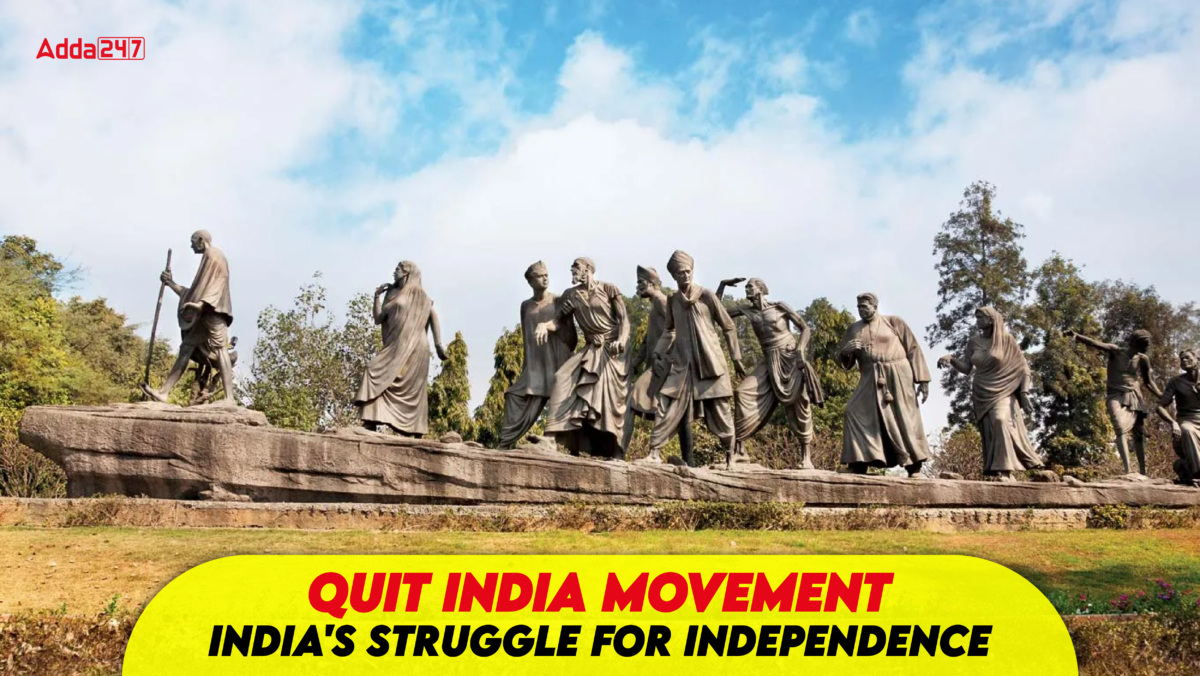Quit India Movement Day, observed on August 8th, marks the historic Quit India Movement led by Mahatma Gandhi in 1942. This pivotal campaign demanded an end to British rule in India, mobilizing millions through non-violent resistance. In 2024, as India commemorates the 82nd anniversary, the day serves as a powerful reminder of the country’s enduring commitment to freedom, democracy, and unity.
Quit India Movement
The Quit India Movement, launched in 1942, was a significant chapter in India’s struggle for independence. It marked a crucial turning point in the fight against British colonial rule. This article explores the support for the movement, the triggers, the phases, and the resulting impact on India’s socio-political landscape.
Historical Background of the Quit India Movement
The Quit India Movement emerged against a backdrop of growing dissatisfaction with British rule, especially after the failure of the Cripps Mission in March 1942. The mission aimed to secure Indian cooperation during World War II but did not satisfy Indian aspirations for complete independence.
When did the Quit India Movement Launch?
On August 8, 1942, during an All India Congress Committee session in Bombay, the Quit India Resolution was adopted. Mahatma Gandhi’s clarion call, “Do or Die,” urged Indians to engage in non-violent resistance against the colonial authorities. The movement saw unprecedented participation from various sections of society, including students, farmers, workers, and political leaders.
Causes of the Quit India Movement
Several factors led to the eruption of the Quit India Movement:
- Failure of the Cripps Mission: In 1942, Sir Stafford Cripps was sent to India to negotiate British support for the Indian contribution to World War II. His proposals included dominion status for India post-war, which was rejected by Congress leaders who demanded complete freedom.
- Refusal of Unconditional Support: The Indian National Congress, led by Gandhi and other leaders, refused to support the British war effort without a clear promise of complete independence.
- Nationwide Enthusiasm for Complete Freedom: The widespread desire for full independence, along with the economic struggles from the war, made many people support the Quit India Movement.
Phases of the Quit India Movement
The Quit India Movement unfolded in three distinct phases:
- Urban Insurrection: This initial phase saw widespread strikes, rallies, and protests in urban areas. Workers demonstrated solidarity by halting factory work. The British response was swift, with Gandhi and many leaders being arrested. This phase ended with severe suppression of the movement.
- Rural Revolts: The focus then shifted to rural areas, where there was significant unrest. The destruction of communication systems, including railway tracks and telegraph cables, as well as attacks on government buildings, characterized this phase.
- Formation of Local Governments: In the final phase, local governments were established at various levels, reflecting the acceptance of alternative authority figures and the growing demand for self-rule.
Key Figures and Slogans
Aruna Asaf Ali
Known as the ‘Grand Old Lady’ of the Independence Movement, Aruna Asaf Ali played a significant role by hoisting the Indian flag at Gowalia Tank Maidan during the Quit India Movement.
Yusuf Meherally
Yusuf Meherally, a socialist and trade unionist who served as Mayor of Mumbai, coined the slogan ‘Quit India’. He was also responsible for the slogan “Simon Go Back”.
Support for the Quit India Movement
The Quit India Movement received widespread backing from Indian leaders, but not all political groups were in favor:
- Communist Party of India: The party did not support the movement due to its alignment with the Soviet Union, which was involved in World War II. Their stance was influenced by the global political context rather than local issues.
- Hindu Mahasabha: Concerned about national safety and security during wartime, the Hindu Mahasabha chose not to support the movement, fearing potential instability.
- Indian Muslim League: The Muslim League was focused on achieving a separate nation, Pakistan, and thus did not back the Quit India Movement, which aimed at complete freedom for India as a unified country.
Key leaders of the Quit India Movement included Mahatma Gandhi, Jawahar Lal Nehru, Maulana Abul Kalam Azad, Subhash Chandra Bose, Biju Patnaik, Aruna Asaf Ali, Ram Manohar Lohia, Usha Mehta, Sucheta Kriplani, and Jai Prakash Narain. Subhash Chandra Bose notably formed the Indian National Army and supported the cause from abroad.
Result of the Quit India Movement
The Quit India Movement had a profound impact on India’s political landscape:
- Emergence of New Leaders: With many Congress leaders imprisoned, figures like Aruna Asaf Ali rose to prominence, becoming the president of the Indian National Congress.
- Political Shifts: The movement allowed organizations such as the Rashtriya Swayamsevak Sangh (RSS), Hindu Mahasabha, and Muslim League to gain prominence. Their increased influence was partly due to the absence of Congress leaders and the prevalent political unrest.
- Legal and Political Changes: The Indian National Congress and its allied organizations were declared unlawful associations. The political climate shifted dramatically, paving the way for new negotiations with the British.
- Public Participation: The movement saw the arrest of around one lakh people, including both leaders and ordinary citizens, reflecting the widespread public commitment to the cause.
- Path to Independence: The Quit India Movement intensified the demand for complete freedom, which, coupled with Britain’s weakened global position post-World War II, eventually led to India’s independence on August 15, 1947.
Significance of the Quit India Movement
The Quit India Movement is significant for several reasons. It mobilized millions of ordinary Indians from all walks of life and demonstrated the unity and determination of the Indian people in their quest for self-rule. Internationally, it drew attention to India’s struggle for independence and garnered support from various quarters, including sympathetic voices within the British public and pressure from Allied powers during World War II.




 What was the Old Name of Goa? Know About...
What was the Old Name of Goa? Know About...
 Top-10 Most Searched Words in 2025, Chec...
Top-10 Most Searched Words in 2025, Chec...
 Which Crop is known as the Backbone of I...
Which Crop is known as the Backbone of I...







